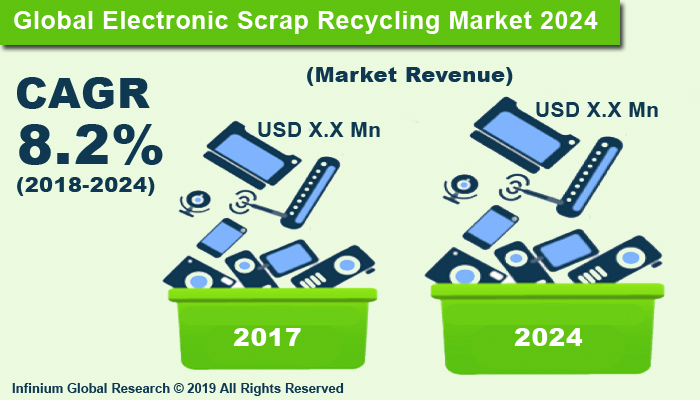Electronic Scrap Recycling Market (Type of Metals Extracted - Precious Metals, Non-ferrous, and Ferrous; E-scrap Generation - IT Equipment and Handheld Devices, Large White Goods, Small Household Appliances, and Others): Global Industry Analysis, Trends, Size, Share and Forecasts to 2024
A recent report published by Infinium Global Research on electronic scrap recycling market provides an in-depth analysis of segments and sub-segments in the global as well as regional electronic scrap recycling market. The study also highlights the impact of drivers, restraints, and macro indicators on the global and regional electronic scrap recycling market over the short term as well as long term. The report is a comprehensive presentation of trends, forecast and dollar values of global electronic scrap recycling market. According to the report, the global electronic scrap recycling market is projected to grow at a CAGR of 8.2% over the forecast period of 2018-2024.

Market Insight
Electronics scrap, also known as e-scrap or e-waste.
Electronic scrap is the trash, which is generated from surplus, broken and
obsolete electronic devices. E-wastes include: home appliances such as
televisions, air conditioners, electric cookers, heaters, air condoners, fans,
DVDs, Radios, and microwaves; information technology types of equipment such as
computers, mobile phones, laptops, batteries, circuit boards, hard disks, and
monitors; and other electronic utilities such as leisure, lighting, and
sporting types of equipment. E-scrap recycling is the process of recovering the useful
material from old devices to use in new products. It is a highly
labor-intensive process and goes through different steps. Steps involved in
e-waste recycling in a sequence is as follows: picking shed, disassembly, a
first size reduction process, a second size reduction process, over-band
magnet, non-metallic, metallic components separation, and water separation.
Many of the materials used in making electronic devices can be recovered, reused
and recycled, including plastic, metals, glass, mercury, printed circuit
boards, hard drives, ink and toner cartridges, and batteries.
Electronics are full of valuable materials including copper,
tin, iron, aluminum, titanium, gold, and silver and some harmful materials such
as lead, cadmium, beryllium, or brominated flame-retardants. Therefore, it is
crucial to recycle e-waste very carefully. Recycling e-waste helps to recover
various valuable metals and other materials from electronics, saving natural
resources (energy), reducing pollution, conserving landfill space, and creating
jobs.
Growing concern about the environment and conserving the
natural resources are the leading drivers of the E-scrap recycling market.
Furthermore, the shelf life of the electronics is less as compared to some
other products; this has led to the disposal of the electronics and their
recycling. Dumping of E-waste results in the contamination of land and water.
By recycling the e-waste, contamination of land and water is reduced. On the
other hand, the process of recycling E-scrap is expensive. This hampers the
growth of e-scrap recycling market. As the concerns, about the environment and
pollution, are increasing many of the state and national governments have taken
some actions. The governments have changed and added many regulations regarding
e-waste disposal. This may act as an opportunity for the e-waste recycling
firm.
Among all the geographical segments, North America is the
largest market for e-scrap recycling. The population of North America has a
significant amount of disposable income to buy new electronic products and
recycle older ones. In the North American region, especially in the USA, the
infrastructure, resources, and technology required for recycling the e-waste
are available. This all have contributed to the large market share of the North
American region.
Segment Covered
The report on global electronic scrap recycling market covers segments such as the type of metals extracted and e-scrap generation. On the basis of the type of metals extracted, the sub-markets include precious metals, non-ferrous, and ferrous. On the basis of e-scrap generation, the sub-markets include IT equipment and handheld devices, large white goods, small household appliances, and others.
Companies Profiled:
The report provides profiles of the companies in the market such as Boliden Group, Mitsubishi Materials U.S.A. Corporation., MITSUI & CO., LTD., JXTG Holdings, Inc., Outotec, ENIRO-HUB HOLDINGS LTD., Glencore, LS-Nikko Copper Inc., Ultromex Limited, and DOWA HOLDINGS Co., Ltd.
Report Highlights:
The report provides deep insights into the demand forecasts, market trends, and micro and macro indicators. In addition, this report provides insights into the factors that are driving and restraining the growth in this market. Moreover, The IGR-Growth Matrix analysis given in the report brings an insight into the investment areas that existing or new market players can consider. The report provides insights into the market using analytical tools such as Porter's five forces analysis and DRO analysis of electronic scrap recycling market. Moreover, the study highlights current market trends and provides forecast from 2018-2024. We also have highlighted future trends in the market that will affect the demand during the forecast period. Moreover, the competitive analysis given in each regional market brings an insight into the market share of the leading players.
